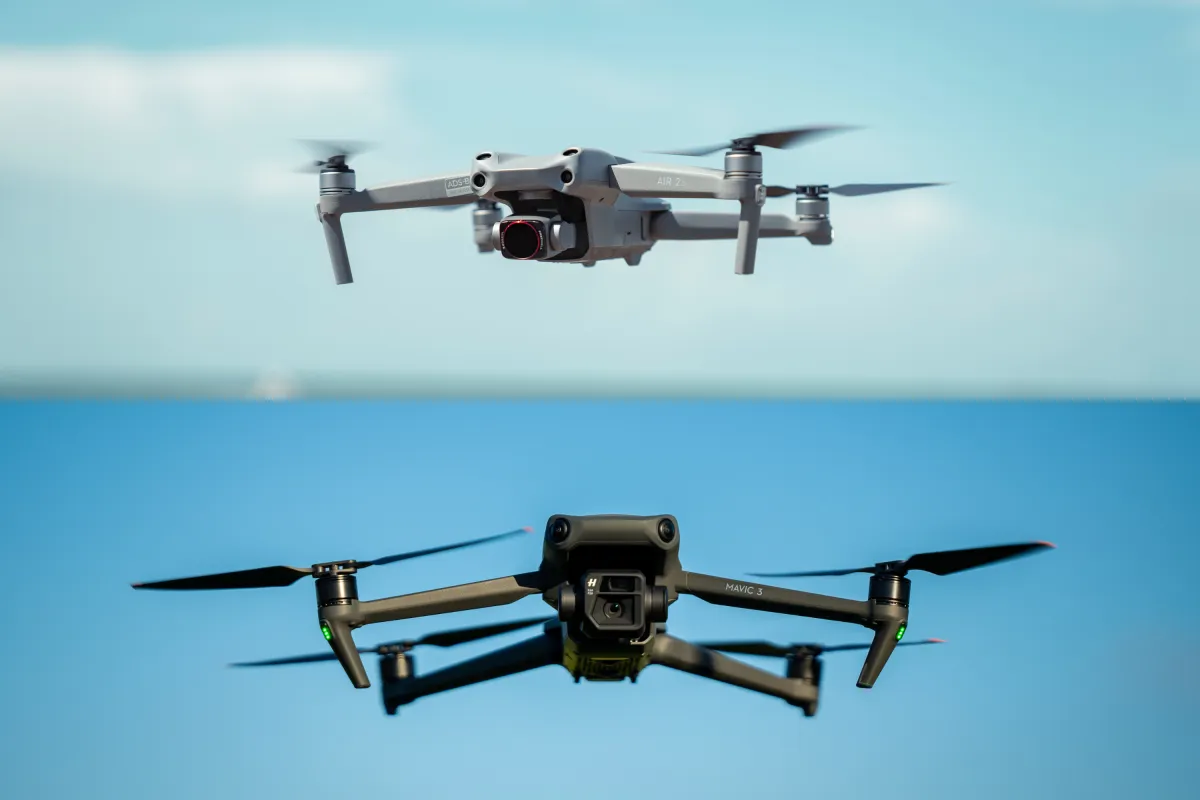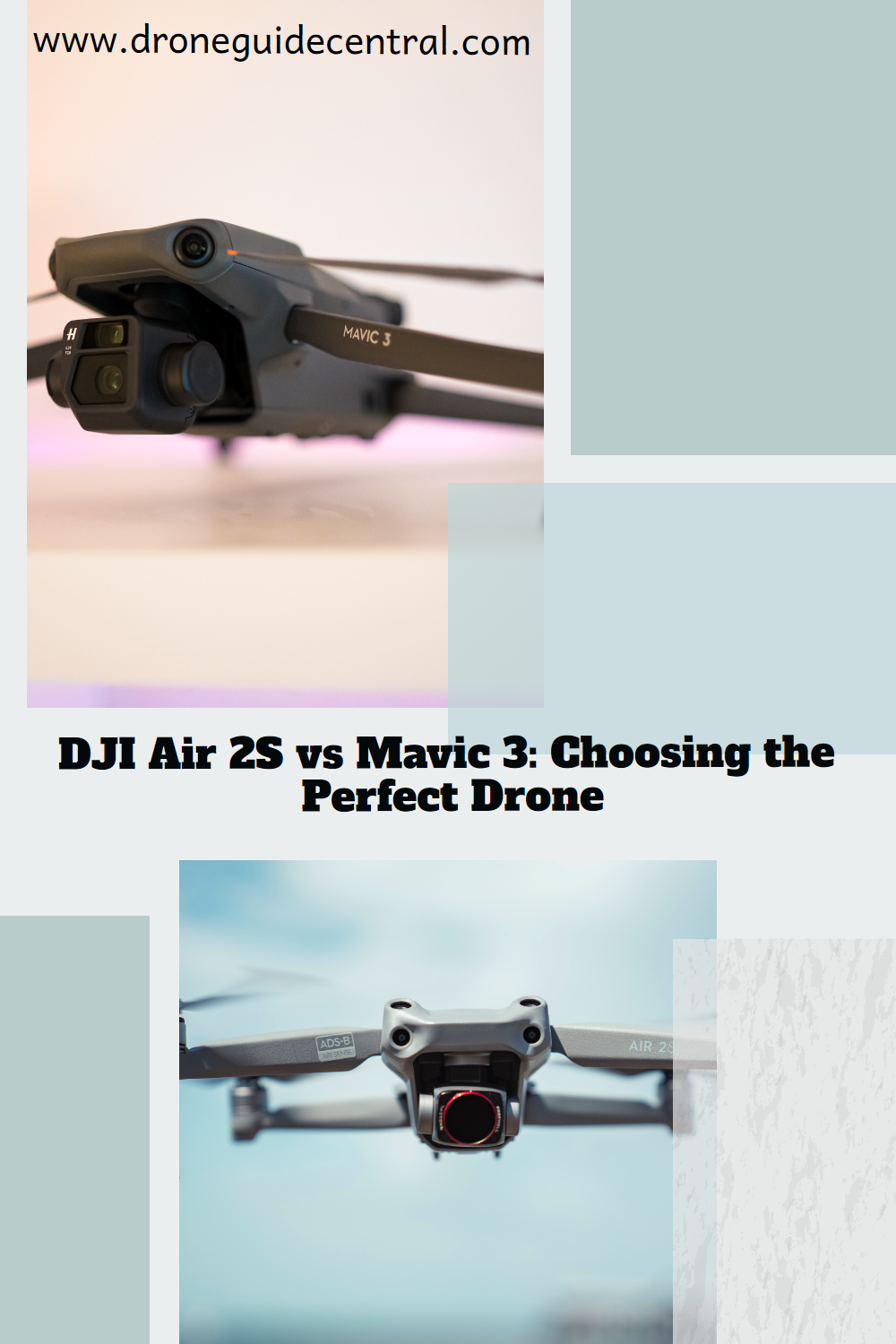
DJI Air 2S vs Mavic 3: Choosing the Perfect Drone
The world of drones has witnessed remarkable advancements in recent years, and DJI remains at the forefront of this technological revolution. Two of their flagship drones, the DJI Air 2S and the Mavic 3, have been creating quite a buzz among enthusiasts and professionals alike. In this article, I'll guide you through the intricate process of choosing between these two outstanding drones, providing suggestions and reasons for your consideration. Let's delve into the detailed comparison of DJI Air 2S vs Mavic 3, exploring their features, capabilities, and which one might be the perfect fit for your aerial adventures.
Key Differences Between DJI Air 2S and Mavic 3
Before we delve into the details, let's outline the key differences that set the DJI Air 2S and the Mavic 3 apart. These aspects will be crucial in making an informed choice.
DJI Air 2S vs Mavic 3: Camera Quality
When it comes to the camera, both the DJI Air 2S and the Mavic 3 offer exceptional performance, but there are notable differences.
Sensor Size and Effective Pixels:
The DJI Mavic 3 takes the lead with its larger 4/3 CMOS sensor in the main camera, offering improved image quality, better low-light performance, and a broader dynamic range compared to the 1" CMOS sensor in the DJI Air 2S. This advantage becomes particularly apparent when capturing detailed shots in challenging lighting conditions.
Both drones share the same effective pixel count at 20 MP, ensuring high-resolution images. However, the Mavic 3 has a dedicated Tele Camera with a 12 MP sensor, providing additional flexibility for different shooting scenarios.
Lens and Aperture:
While the DJI Air 2S boasts a slightly wider field of view (FOV) at 88° compared to the Mavic 3's 84° in the main Hasselblad camera, the Mavic 3 compensates with a variable aperture spanning from f/2.8 to f/11. This feature grants users greater control over exposure, especially in varying lighting conditions, making the Mavic 3 an adaptable choice for professional photographers.
The Mavic 3's Tele Camera, with its narrow FOV of 15°, is specifically designed for capturing distant subjects, offering a unique advantage for users who require a more powerful zoom.
ISO Range:
Both drones offer a similar ISO range for video and still photography, but the Mavic 3's larger sensor may provide an edge in producing cleaner, less noisy images, particularly at higher ISO settings. This is advantageous in situations where lighting is less than ideal.
Video Resolution and Bitrate:
The Mavic 3 excels in video capabilities, surpassing the Air 2S with its impressive features. Offering a remarkable 5.1K resolution at 50 fps, along with DCI 4K at an impressive 120 fps, the Mavic 3 sets a new standard for detail capture and provides unmatched flexibility in post-production editing.
With a higher maximum bitrate of 200 Mbps, the Mavic 3 ensures the preservation of intricate details in every frame, making it an exceptional choice for content creators who demand top-tier video quality. The inclusion of DCI 4K further solidifies the Mavic 3's standing as a preferred option for professional video production.
In contrast, the Air 2S, providing 5.4K at 30 fps and 4K Ultra HD at 60 fps, lags behind with a bitrate of 150 Mbps. This establishes the Mavic 3 as the preferred choice for individuals in search of top-notch video recording capabilities.
Digital Zoom:
Both drones offer digital zoom capabilities. However, the DJI Mavic 3's zoom range of 7-28x is more extensive than the DJI Air 2S, which maxes out at 8x. This extended zoom range allows for greater creative freedom when framing shots or getting closer to distant subjects.
Supported File Formats:
Both drones support popular video formats (MP4, MOV) with advanced compression (H.264, H.265). For photos, both offer JPEG for standard images and DNG (RAW) for extensive post-processing.
The Air 2S supports FAT32 and exFAT, catering to different storage preferences. In comparison, the Mavic 3 exclusively employs the efficient exFAT file system, often favored for handling larger video files and ensuring data integrity. This is particularly important for professional videographers who need to maintain the highest quality during post-production.
In summary, the DJI Mavic 3 excels in several key camera specifications, including its larger sensor size, adjustable aperture, improved video resolution, higher bitrate, and extended zoom capabilities. These advantages make it an excellent choice for professional photographers and videographers who demand top-tier image and video quality.
However, the DJI Air 2S still offers outstanding performance, especially for enthusiasts and those with budget considerations, and it remains a solid option for capturing high-quality content.
Related read: DJI Air 3
DJI Air 2S vs Mavic 3: Flight Performance
The DJI Air 2S impresses with a flight time of 31 minutes and a top speed of 42.5 mph. It has a maximum ascent and descent speed of 13.42 mph and a maximum wind speed resistance of 24 mph. Its 4 directional obstacle sensors provide reliable collision avoidance, enhancing flight safety.
The drone utilizes the O3 transmission system with a maximum distance of 7.4 miles / 12 km (FCC), and 4.9 miles / 8 km in other regions, and features a live view quality of 1080p/30fps.
In contrast, the Mavic 3 surpasses this with an even longer flight time of 46 minutes and a top speed of 46 mph. Notably, the Mavic 3 surpasses the Air 2S with a superior maximum ascent speed of 17.9 mph and a higher maximum wind speed resistance of 26.84 mph. The upgraded omnidirectional obstacle avoidance system in the Mavic 3 offers a greater sense of security during flight.
Additionally, the Mavic 3 employs the O3+ transmission system, supporting a live view quality of 1080p@30fps/1080p@60fps, with an impressive FCC max transmission distance of 9.3 miles / 15 km and 4.9 miles / 8 km in other regions. These features collectively make the Mavic 3 a powerhouse for both flight performance and advanced aerial capabilities.
DJI Air 2S vs Mavic 3: Portability and Design
If you frequently travel or enjoy hiking, the portability of your drone is pivotal. The DJI Air 2S is the winner in this category. Weighing only 1.31 pounds (595 g) and with folded dimensions of 7.09 x 3.82 x 3.03 inches (180 x 97 x 77 mm), it's compact, lightweight, and effortlessly portable, rendering it a perfect selection for adventurers.
On the other hand, the Mavic 3, while still portable, is slightly bulkier due to its more robust cameras and additional features. With a takeoff weight of 1.97 pounds (895 g) and folded dimensions of 8.7 x 3.79 x 3.55 inches (221 x 96.3 x 90.3 mm), it remains a viable option for on-the-go photography and videography.
If you prioritize camera quality over extreme portability, this may not be a significant concern, considering the added capabilities the Mavic 3 brings to the table.
Pricing
Now, let's address the pricing elephant in the room. The DJI Air 2S is notably more affordable than the Mavic 3. For those mindful of budget constraints, the Air 2S strikes an excellent balance of quality and cost-effectiveness.
However, for those who are willing to make a substantial investment, the Mavic 3 justifies its higher price point with superior cameras, extended flight time, and advanced features. The added capabilities and enhanced performance make the Mavic 3 an ideal choice for professionals and enthusiasts who prioritize top-tier drone technology.
Advanced Features
Both drones come equipped with DJI's signature intelligent flight modes and tracking features. However, the Mavic 3 offers an enhanced experience with more precise tracking capabilities, including Advanced ActiveTrack 5.0.
Choosing the Right Drone
In conclusion, selecting between the DJI Air 2S and Mavic 3 comes down to your specific requirements. If you're a photography or videography enthusiast on a budget, seeking superb image quality without the highest professional standards, the Air 2S is more than adequate. However, if you're a professional who demands the absolute best in camera quality and flight performance, the Mavic 3 is the ultimate choice.
DJI Air 2S vs Mavic 3: FAQs
FAQ 1: What is the main difference between the DJI Air 2S and Mavic 3?
The primary distinction lies in their intended user base and use cases. The DJI Air 2S is a versatile drone catering to enthusiasts and semi-professionals, offering a great balance of features and affordability.
On the other hand, the Mavic 3 is a more advanced and professional-grade drone with superior camera capabilities, longer flight time, and enhanced obstacle avoidance systems, making it ideal for professional photographers and filmmakers seeking top-tier performance.
FAQ 2: Which drone is more suitable for beginners?
The DJI Air 2S is more suitable for beginners due to its user-friendly features, relatively lower price point, and a balance of performance capabilities. Its intelligent flight modes, obstacle sensors, and straightforward controls make it accessible for those new to drone piloting. The Mavic 3, with its advanced features and higher price, is better suited for experienced users or professionals.
FAQ 3: Can the DJI Air 2S and Mavic 3 handle windy conditions?
Both the DJI Air 2S and Mavic 3 are designed to handle windy conditions with effective stabilization systems. However, the Mavic 3, with its higher maximum wind speed resistance of 26.84 mph, may have a slight edge in maintaining stability during challenging weather conditions.
FAQ 4: Are there any bundle options or accessories worth considering?
DJI often offers various bundle options for both the Air 2S and Mavic 3, including Fly More Combos with additional batteries, propellers, and carrying cases. Consider these bundles for a more comprehensive and cost-effective package. Additionally, accessories like ND filters, spare batteries, and a landing pad can enhance your overall drone experience.
FAQ 5: Do both drones have geofencing and no-fly zone restrictions?
Yes, both the DJI Air 2S and Mavic 3 come equipped with geofencing and no-fly zone restrictions. These features are designed to enhance safety by preventing drones from entering restricted airspace or potentially hazardous areas. Users should always be aware of and adhere to local regulations and no-fly zones when operating these drones.
Explore further within the articles available on ieee.org and ncbi.gov.

Copyright © Drone Guide Central - All Rights Reserved 2024

